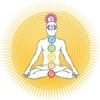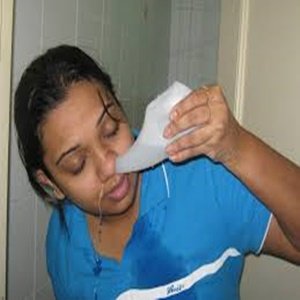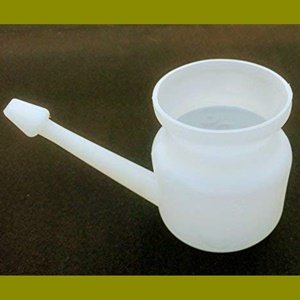Description
Benefits of Jal Neti
- Neti removes all the dirt and bacteria-filled mucus from within the nose.
- It also helps to drain the sinus cavities. This, in turn, will help to reprogram the body’s natural mechanisms against nasal infections such as hay fever, allergies, sinusitis, and other upper respiratory complaints like sore throats and coughs, postnasal drip, inflammation of tonsils, and adenoids.
- It is beneficial for illnesses such as asthma and bronchitis as it reduces the tendency for mouth breathing by freeing the nostrils of mucus.
- It has a cooling and soothing effect on the brain by drawing out excessive heat and is therefore beneficial for headaches, migraine, epilepsy, temper tantrums, hysteria, depression, and general mental tension.
- Neti is of great benefit for problems associated with the eyes. It helps flush the tear ducts, encouraging clearer vision and giving a sparkle to the eyes.
- It can be beneficial for certain types of ear disorders such as middle ear infections, glue ear, and tinnitus.
- Neti improves the sensitivity of the olfactory nerves, helping to restore the lost sense of smell, and thereby benefits the relationship between taste and the digestive processes.
- It has subtle effects on the pineal and pituitary glands which control the hormonal system. This has a harmonizing effect on emotional behavior.
- Neti affects the psychic center known as Ajna Chakra which helps in awakening higher states of meditation.
- It helps to stimulate better powers of visualization and concentration and gives a feeling of lightness and clarity to the mind.
- Neti is excellent for those trying to give up smoking. Since it reduces the tendency for mouth breathing, Neti re-sensitizes the nose to the actual pollution of ingesting smoke, thereby de-programming the brain of the physical and psychological addiction.
Method of Doing Jal Neti
Nasal cleansing can be performed over a sink, a bowl on a table, in the shower, or outside.
1. First fill the Neti Pot with warm water at a temperature suitable for pouring in the nose. Neither too hot or cold. Just like testing a baby’s bottle, pour a bit on your arm or taste and spit to check the temperature. A little hotter than warm is better than colder. Pure water is best if available. Mix in salt to the proportion of one teaspoon for half a liter of water. This equates to 0.9% and is called isotonic solution – the same as human blood. Sea salt is best if available. Mix the salt thoroughly. Taste the water and spit, to be sure of the correct mix and temperature. It will not be as salty as seawater. Adjust if not correct. After several attempts, you will be able to recognize the exact correct mixture by taste.
2. Place the nose cone into the right nostril, sealing it inside the nostril with a few twists and slight pressure. Try to point the spout straight up in line with the nasal passage so as not to block off the tip of the nozzle on the inside of the nose. Open your mouth and breathe gently through the mouth. Try not to sniff, swallow, laugh, talk, or have any movement of air through the nose whilst the water is flowing through.
3. Now slowly bend forward from the waist so that the tip of the nose is the lowest point of the head; and then tilt/roll the head to the right, so that the left nostril is now the lowest point of the nose. Tilt slowly so that water doesn’t run out the top of the pot onto your face. Keep the nose cone fully sealed into the right nostril so that it doesn’t leak. Keep on mouth breathing whiles the water comes through. Just wait a few seconds and the water should run out the left nostril. keep breathing slowly and gently through the mouth. After the water begins to run, wait about 30 seconds for about half a pot to flow right to left, and then remove the pot and stand up.
4. Before changing sides, blow out gently through both nostrils to clear water and mucus from the nose.
5. Repeat steps 2 & 3 as above, but with the nose cone entering the left nostril and the flow of water going left to right. After the pot runs dry, stand up, blow out gently through both nostrils, and then prepare to dry out the nose.
6. If after doing the above steps, there is still a mucus blockage, the whole process may be repeated several times until it clears. If this still fails to clear the nose, it is recommended that you visit a doctor to ascertain if there is some structural blockage in the nose.
Drying The Nose
1. Drying the nose properly is a very important part of the practice. Never neglect to do this part properly. People with high blood pressure should be careful of this part. If dizziness results when draining the nose, drying should only be done standing upright.
2. First bend forwards from the waist and hang the head upside down with the nose pointing towards the floor, letting any residual water drain from the nose. Then point the nose towards the knees. In each position, gently breathe in the mouth and out the nose about 10 times. A few droplets of water may run down.
3. Then stand up to do some rapid breathing through the nostrils. First, do 10 breaths through both nostrils together, sniffing in and out moderately with a bit more emphasis on the exhalation. Then close off the right nostril with one finger and do 10 rapid sniffing breaths through the left nostril only. Then do 10 sniffing breaths through the right nostril only. Finally, do 10 breaths again through both nostrils together. This should clear and dry the nose. If it feels as if there is still some water in there, repeat the whole drying process. Failure to dry the nose properly may manifest the symptoms of a cold for several hours, or leaving dirty water in the sinus passages or eustachian tubes may result in infection!






Reviews
There are no reviews yet.